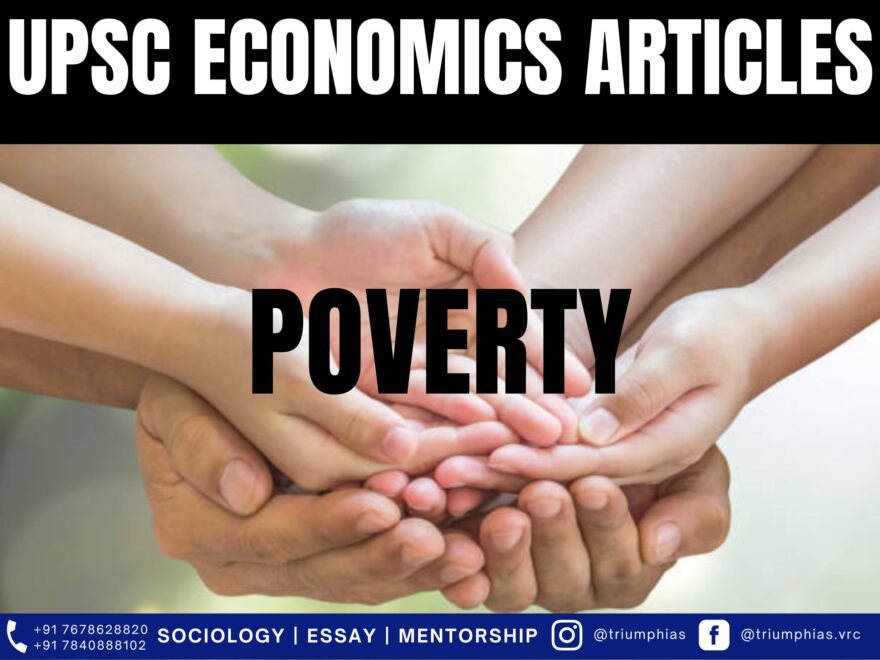Poverty
(Relevant for Economics Section of General Studies Paper Prelims/Mains)

Poverty signifies a state or circumstance wherein an individual or a community lacks the necessary financial means and fundamental requisites to achieve a basic standard of living. It indicates that the earnings derived from employment fall to such a minimal extent that fundamental human necessities remain unattainable.
As per the World Bank’s perspective, poverty denotes significant deprivation in overall well-being and encompasses multifaceted dimensions. This encompasses inadequate income levels and the incapability to secure essential commodities and services vital for survival with dignity. Moreover, poverty encompasses limited access to proper healthcare and education, deficient availability of clean water and sanitation facilities, insufficient physical safety, absence of empowerment, and limited potential and opportunities to enhance one’s quality of life.
Within India, as of 2011, around 21.9% of the population resides below the national poverty threshold.
In 2018, nearly 8% of the global workforce and their families were constrained to subsist on an income of less than US$1.90 per individual per day, in line with the international poverty benchmark.
Poverty estimation in india
- Poverty assessment in India is conducted by NITI Aayog’s task force, employing data gathered by the National Sample Survey Office under the Ministry of Statistics and Programme Implementation (MOSPI). The poverty line in India is determined by calculating the poverty threshold, which relies on consumption expenditure rather than income levels.
- In India, the evaluation of poverty is based on consumer expenditure surveys carried out by the National Sample Survey Organisation. A household is classified as poor if its expenditure falls below a specified poverty line. The extent of poverty is gauged through the poverty ratio, denoting the proportion of the impoverished population to the total population, presented as a percentage and commonly referred to as the head-count ratio.
- The Alagh Committee (1979) established the poverty line considering a daily minimum caloric intake of 2400 and 2100 calories for adults in rural and urban areas, respectively. Subsequent committees, such as the Lakdawala Committee (1993), Tendulkar Committee (2009), and Rangarajan Committee (2012), have contributed to refining poverty estimation methodologies.
- According to the Rangarajan committee’s findings (2014), the poverty line is set at a Monthly Per Capita Expenditure of Rs. 1407 in urban regions and Rs. 972 in rural areas.
- Population Explosion: India’s population has consistently surged over the years. In the past 45 years, it has grown at an annual rate of 2.2%, signifying an average addition of approximately 17 million individuals to the country’s populace each year. This surge further escalates the demand for consumer goods substantially.
- Diminished Agricultural Productivity: A pivotal factor contributing to poverty is the low productivity within the agricultural sector. This situation is multifaceted. Primarily, it stems from fragmented and divided land holdings, lack of access to capital, ignorance regarding modern farming technologies, reliance on conventional cultivation techniques, and losses during storage.
- Inefficient Resource Utilization: The prevalence of underemployment and concealed unemployment, particularly in the agricultural domain, has resulted in diminished agricultural output and a corresponding decline in living standards.
- Limited Economic Growth Rate: Economic advancement has been sluggish in India, particularly during the initial 40 years following independence, prior to the economic liberalization reforms in 1991.
- Escalating Prices: Persistent inflation in the country has augmented the hardships endured by the impoverished. While a small portion of the population has benefited, those from lower income strata have borne the brunt, struggling to meet even their most basic needs.
- Unemployment: Unemployment stands as another notable contributor to poverty in India. The surging population has led to a concurrent surge in job seekers, but the growth of job opportunities has not kept pace with the escalating demand.
- Shortage of Capital and Entrepreneurial Ventures: The insufficiency of capital and entrepreneurial activities has resulted in low investment levels and insufficient job creation within the economy.
- Social Factors: Beyond economic factors, various social barriers obstruct the eradication of poverty in India. Some of these hindrances include inheritance laws, the caste system, and certain entrenched traditions.
- Colonial Exploitation: The two-century-long British colonization and dominion over India had a detrimental impact, causing the decline of traditional handicraft and textile industries. The colonial policies converted India into a mere supplier of raw materials for European industries.
- Climatic Influences: The majority of India’s impoverished population resides in states like Bihar, Uttar Pradesh, Madhya Pradesh, Chhattisgarh, Odisha, Jharkhand, among others. Natural calamities such as frequent floods, disasters, earthquakes, and cyclones heavily impact agriculture in these regions.
The Global Multidimensional Poverty Index-2018, issued by the UN, highlighted that around 271 million individuals transitioned out of destitution between 2005-06 and 2015-16 within India. The poverty rate within the nation has nearly halved, plummeting from 55% to 28% over the course of a decade. Nevertheless, a substantial segment of India’s population still resides below the Poverty Line.The swift expansion of the economy and the integration of technology into social sector initiatives have played a pivotal role in significantly reducing extreme poverty within the country.Despite the rapid strides made in terms of growth and advancement, an unacceptably large portion of our populace continues to grapple with extensive and varied forms of deprivation. Consequently, addressing poverty in India necessitates a more comprehensive and all-encompassing strategy.
To master these intricacies and fare well in the Sociology Optional Syllabus, aspiring sociologists might benefit from guidance by the Best Sociology Optional Teacher and participation in the Best Sociology Optional Coaching. These avenues provide comprehensive assistance, ensuring a solid understanding of sociology’s diverse methodologies and techniques.
poverty in India, poverty estimation, poverty causes, poverty line, NITI Aayog, National Sample Survey Office, MOSPI, Alagh Committee, Lakdawala Committee, Tendulkar Committee, Rangarajan Committee, population explosion, agricultural productivity, resource utilization, economic growth rate, inflation, unemployment, capital shortage, social factors, colonial exploitation, climatic influences, Global Multidimensional Poverty Index, poverty reduction, technology integration, social sector initiatives, Best Sociology Optional Coaching, Sociology Optional Syllabus.

Choose The Best Sociology Optional Teacher for IAS Preparation?
At the beginning of the journey for Civil Services Examination preparation, many students face a pivotal decision – selecting their optional subject. Questions such as “which optional subject is the best?” and “which optional subject is the most scoring?” frequently come to mind. Choosing the right optional subject, like choosing the best sociology optional teacher, is a subjective yet vital step that requires a thoughtful decision based on facts. A misstep in this crucial decision can indeed prove disastrous.
Ever since the exam pattern was revamped in 2013, the UPSC has eliminated the need for a second optional subject. Now, candidates have to choose only one optional subject for the UPSC Mains, which has two papers of 250 marks each. One of the compelling choices for many has been the sociology optional. However, it’s strongly advised to decide on your optional subject for mains well ahead of time to get sufficient time to complete the syllabus. After all, most students score similarly in General Studies Papers; it’s the score in the optional subject & essay that contributes significantly to the final selection.
“A sound strategy does not rely solely on the popular
Opinion of toppers or famous YouTubers cum teachers.”
It requires understanding one’s ability, interest, and the relevance of the subject, not just for the exam but also for life in general. Hence, when selecting the best sociology teacher, one must consider the usefulness of sociology optional coaching in General Studies, Essay, and Personality Test.
The choice of the optional subject should be based on objective criteria, such as the nature, scope, and size of the syllabus, uniformity and stability in the question pattern, relevance of the syllabic content in daily life in society, and the availability of study material and guidance. For example, choosing the best sociology optional coaching can ensure access to top-quality study materials and experienced teachers. Always remember, the approach of the UPSC optional subject differs from your academic studies of subjects. Therefore, before settling for sociology optional, you need to analyze the syllabus, previous years’ pattern, subject requirements (be it ideal, visionary, numerical, conceptual theoretical), and your comfort level with the subject.
This decision marks a critical point in your UPSC – CSE journey, potentially determining your success in a career in IAS/Civil Services. Therefore, it’s crucial to choose wisely, whether it’s the optional subject or the best sociology optional teacher. Always base your decision on accurate facts, and never let your emotional biases guide your choices. After all, the search for the best sociology optional coaching is about finding the perfect fit for your unique academic needs and aspirations.
To master these intricacies and fare well in the Sociology Optional Syllabus, aspiring sociologists might benefit from guidance by the Best Sociology Optional Teacher and participation in the Best Sociology Optional Coaching. These avenues provide comprehensive assistance, ensuring a solid understanding of sociology’s diverse methodologies and techniques. Sociology, Social theory, Best Sociology Optional Teacher, Best Sociology Optional Coaching, Sociology Optional Syllabus.
Best Sociology Optional Teacher, Sociology Syllabus, Sociology Optional, Sociology Optional Coaching, Best Sociology Optional Coaching, Best Sociology Teacher, Sociology Course, Sociology Teacher, Sociology Foundation, Sociology Foundation Course, Sociology Optional UPSC, Sociology for IAS,
Follow us :
🔎 https://www.instagram.com/triumphias
🔎https://www.youtube.com/c/TriumphIAS
https://t.me/VikashRanjanSociology
Find More Blogs
|
Scope of the subject and comparison with other social sciences |
|||
|
|
|
|
Modernity and social changes in Europe |

